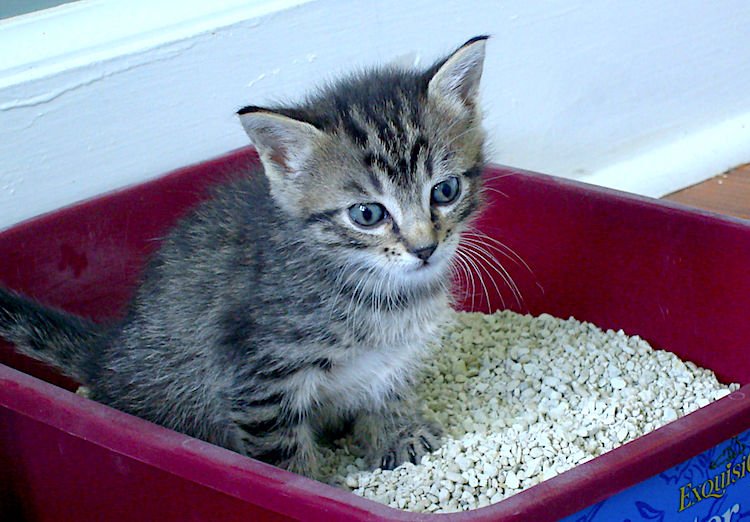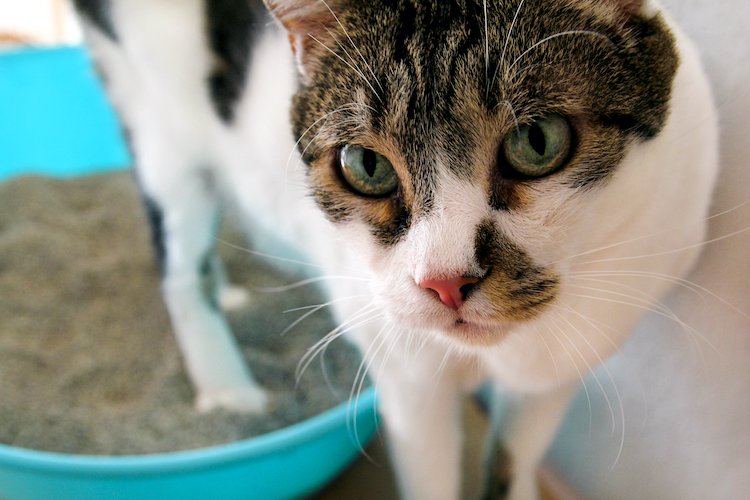Can cats get bladder infections from a dirty litter box? Yes and no.
Yes, dirty litter boxes can cause bladder problems — but not so much infection as the inflammatory condition known as feline lower urinary tract disease (FLUTD).
To put things simply, a dirty litter box is a bad idea that can cause your cat distress and has implications for your pocketbook (due to expensive veterinary visits).
The Link Between a Dirty Litter Box and FLUTD
Cats find a dirty litter box an affront to their dignity.
Without the cat equivalent of a clean toilet and soft toilet paper, they face a stark choice. Hold on and hope someone finally cleans the tray, use a facility they find repellent, or find their own spot to relieve themselves.
These decisions cause the cat stress.
And stress is a very real thing that causes an increase in hormones such as cortisol and adrenaline. These have a knock-on physiological effect on the body. For cats, this shows up as inflammation of the nerves supplying the bladder, leading to inflammation of the bladder wall.
An inflamed bladder sends out a similar message to a full bladder. The cat believes they need to pee. Only there’s a problem … because the tray is dirty.
See where this is going?
It’s a vicious circle of stress and more stress that doesn’t end well.
Infection vs. Inflammation
But what about infection?
Actually, a true urine infection is relatively uncommon in cats, especially in young ones.
The statistics tell us that for every 100 young cats showing signs of difficulty peeing, only 3 will have an infection. The other 97 are all the result of bladder inflammation.
However, bladder infections become more common in older cats or those with health problems such as diabetes mellitus or kidney disease, or those with suppressed immune systems. (More on this later.)
The problem being, the symptoms of a urinary tract infection (UTI) are the same as those of a bladder inflammation. So what are these signs?
Symptoms of a Bladder Problem in a Cat
Long story short, all cats with a sore bladder need to see the veterinarian. Although the signs are similar, the causes and treatments vary.
Also, a cat (especially males) having difficulty peeing is at risk of a complete blockage, regardless of the cause — which can become life-threatening.
The signs that signal a bladder problem include:
If you ignore these signs, there’s a risk of a blood clot or debris plugging the urethra, which is the narrow tube the cat pees through. This is an emergency.
Clues to this include:
- An agitated, distressed cat
- Refusing food
- Dullness and extreme lethargy
- Collapse, lapsing into unconsciousness
Sadly, the consequences of an untreated blocked cat are dire. It can result in lasting kidney damage or even sudden death due to a heart attack. Hence the importance of seeing a vet — and the earlier, the better.

Is a Dirty Litter Box the Only Cause of FLUTD in Cats?
A dirty tray is one source of stress. But this isn’t the only tray-related source of disquiet for a cat.
Feral cats use separate spots to urinate and defecate. In other words, cats naturally like to keep their business separate.
For a particularly sensitive house cat, having to use just one tray for both functions can be stressful. This is amplified in a multi-cat household, where each cat needs their own tray.
The golden rule is:
- One litter box per cat, plus one spare.
Do the math: For 3 cats this means 4 trays, and so on.
Another source of stress is the location of the tray. The cat needs to feel secure while relieving themselves.
The classic example is the litter box situated next to a washing machine. If the cat is using the box when the machine lurches into a spin cycle, the cat may link the tray to a traumatic experience. This causes stress and internal conflict every time the cat wants to visit the box.
And on the subject, some cats even find the wrong substrate (litter) in the box distressing.
Try to stick with a litter that your cat knows and loves. Cats are creatures of habit, and a change to an unfamiliar litter may rock your cat’s world (in a bad way.)
Treatment and Prevention of FLUTD
Prevention is better than cure.
Take a look at the following suggestions to help keep a chilled kitty:
- Provide plenty of trays (one per cat, plus one spare).
- Place each tray in its own private spot (don’t line them up in a row).
- Stick with one brand of cat litter.
- Don’t place food or water bowls beside the tray.
- Keep the box clean.
- Have a relaxed atmosphere in the home.
If your cat does develop symptoms, always see the vet, who will feel the cat’s belly to check if the bladder is blocked or not. For patients who are not blocked, treatment includes non-steroidal anti-inflammatories (for example, meloxicam) to reduce bladder soreness.
Blocked cats require heavy sedation or anesthesia to catheterize the bladder and relieve the pressure.
The vet may also want to investigate to rule out physical causes of a sore bladder, such as:
In recurrent cases, the vet may suggest calming strategies such as using Zylkene (a food supplement with a calming effect), Feliway (a synthetic hormone that reduces stress) and improved litter box hygiene.

3 Common Causes of Bladder Infections in Cats
OK, this is all very well, but what if your young cat is one of the 3% that does have an infection?
How do cats get a bladder infection? The main causes are:
1. An Ascending Infection
This is a fancy way of saying it’s an infection that travels from the outside inward. This is where a dirty litter box comes in.
When the cat’s “trousers” become soiled with feces, their rear end is contaminated with bacteria. And if those bacteria move into the urethra, they can travel upward to the bladder. This is most likely to happen in female cats than males, due to their anatomy.
Ascending infections are more likely in cats with poor personal hygiene (don’t groom around their back end), those with long fur (because it traps more bacteria) or cats who like to sleep in the litter box.
2. Poor-Quality Urine
Normal urine has built-in disinfectant properties. Factors such as the acidity and concentration of the urine make it a more hostile environment for bacteria to survive.
But some health problems mean the cat’s natural biochemistry is altered, which in turn affects the quality of their urine.
- One example is the cat with kidney disease. A struggling kidney isn’t able to concentrate urine to its typical apple juice appearance, and instead it’s much more watery. This weak urine is equivalent to over-diluted disinfectant and loses many of its beneficial properties.
- Another example is the diabetic cat with glucose in their urine. Sugary pee “feeds” bacteria and can make a great environment for the bacteria to grow in. Hence why UTIs are more common in diabetics.
3. Poor Bladder Health
Even if there are bacteria in the urine, this doesn’t automatically mean an infection develops. Again, a healthy bladder has barrier properties that help keep it healthy.
However, if bladder health is reduced and the lining becomes damaged, this can allow bacteria to get a grip.
Examples of damage to the bladder wall include:
- Crystals in the urine that act like abrasive sandpaper
- Bladder stones that rattle around like a shoe in a dryer
- Bladder polyps or cancer
- Stress causing bladder inflammation

How Are Bladder Infections Diagnosed in Cats?
When the symptoms of infection are the same as those of inflammation, how does the vet reach a diagnosis?
In most cases, this rests of submitting a urine sample for culture. This process attempts to grow any bacteria present and identify which antibiotic will kill them.
Alternatively, there is a simple lab test vets can do in-house that gives a “yes/no” on whether or not there is an infection. If the test comes back “yes,” then the sample may still need to go for culture, but it does avoid sending samples away unnecessarily.
A vet who strongly suspects an infection in a new patient may decide to treat with antibiotic without culture. However, if the symptoms come back soon after treatment finishes, then culture is essential to get to the bottom of things.
How Do You Collect a Urine Sample From a Cat?
It’s not easy!
The easiest way to collect a urine sample from your cat is to take a clean, empty litter box and put nonabsorbent pellets in it.
- Your vet can supply you with Katkor, which are small plastic beads that don’t soak up urine when peed on. The idea is that the cat goes in the tray and you use a small pipette that comes with the Katkor to suck up a sample.
- An alternative is aquarium gravel. Just be sure to rinse it well first to get rid of dirt and dust, disinfect it with boiling water, and dry it completely before putting it in the tray.
If all else fails and you can’t get a sample at home, please speak with your vet.
- The vet may be able to collect a sample via cystocentesis (inserting a sterile needle into a full bladder and collecting a sample).
- Or they may be willing to hospitalize the cat with a tray, until the cat obliges and pees in it.
Final Thoughts
So, to recap: Can cats get urine infections from a dirty litter box?
Again, the answer is yes … and no.
The take-home message is that a clean litter box makes for a happy cat — which is what we all want at the end of the day.
In the video below, Dr. Patrick McHale, DVM, shares more about how veterinarians treat urinary tract infection in cats:
References
+ Click to see the sources for this article.
 This pet health content was written by a veterinarian, Dr. Pippa Elliott, BVMS, MRCVS. It was last reviewed Feb. 4, 2020.
This pet health content was written by a veterinarian, Dr. Pippa Elliott, BVMS, MRCVS. It was last reviewed Feb. 4, 2020.
Read This Next


